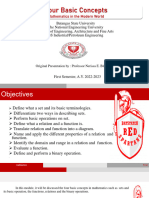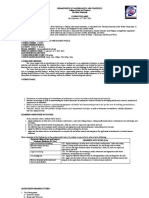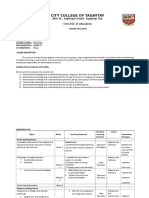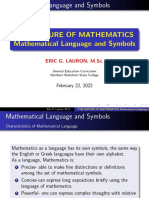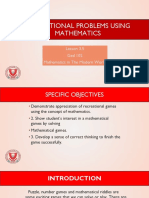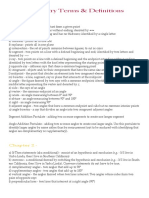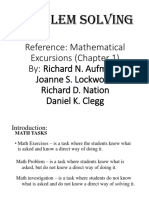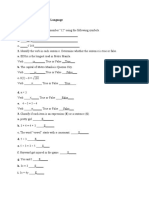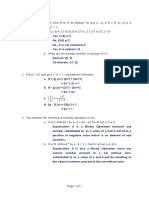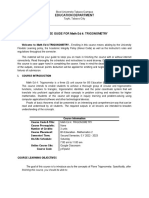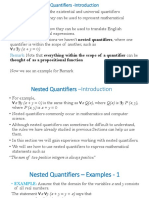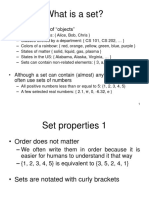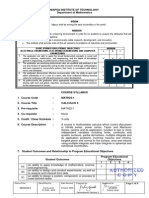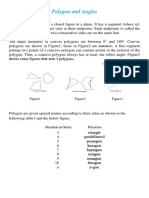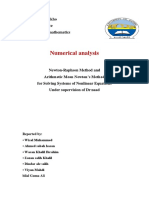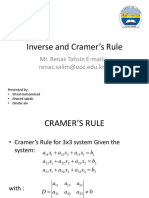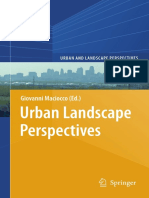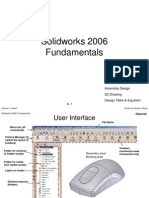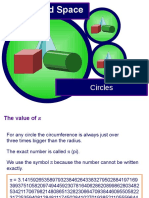Republic of Kurdistan
University of Zakho
Faculty of Science
Department of Mathematics
MATHEMATICAL ANALYSIS
Semester 6
Week 5’s Lectures
(Lecture 7)
Prepared by
Ibrahim S. Ibrahim
2020-2021
� University of Zakho Mathematical Analysis
CHAPTER 4. METRIC SPACE
4.6. COMPACT SPACES IN A METRIC SPACE
Definition 4.6.1 (Cover & Open cover)
A cover of a set 𝑆 in a metric space 𝑋 is a collection {𝐺𝜆 }λ∈Δ of subsets of 𝑋 such that
𝑆 ⊂ ⋃ 𝐺𝜆.
λ∈Δ
If 𝐺𝜆 is an open set ∀λ ∈ Δ, then the collection {𝐺𝜆 }λ∈Δ is called an open cover of 𝑆.
Definition 4.6.2 (Subcover)
A subset of {𝐺𝜆 }λ∈Δ that is also an open cover of 𝑆 is a subcover.
Definition 4.6.3 (Compact)
A subset 𝑆 of a metric space 𝑋 is said to be compact if every open cover of 𝑆 has a finite
subcover.
I.e., if {𝐺𝜆 }λ∈Δ is an open cover of 𝑆, then there are finitely many open sets
𝐺𝜆1 , 𝐺𝜆2 , … , 𝐺𝜆𝑛
such that
𝑆 ⊂ 𝐺𝜆1 ∪ 𝐺𝜆2 ∪ … ∪ 𝐺𝜆𝑛
𝑛
𝑆 ⊂ ⋃ 𝐺𝜆𝑖 .
𝑖=1
In particular, the metric space 𝑿 is said to be compact if for every collection {𝐺𝜆 }λ∈Δ
of open sets in 𝑋 for which 𝑋 = ⋃λ∈Δ 𝐺𝜆 , there exist finitely many open sets
𝐺𝜆1 , 𝐺𝜆2 , … , 𝐺𝜆𝑛
such that
2
� University of Zakho Prepared by Ibrahim S. Ibrahim
𝑋 = ⋃ 𝐺𝜆𝑖 .
𝑖=1
Example 4.6.1 Show that (0, 1] is not compact in ℝ.
1
Solution. Let {(𝑛 , 2)} be an open cover of (0, 1], i.e.,
𝑛∈ℕ
1
(0, 1] ⊂ ⋃ ( , 2) .
𝑛
𝑛∈ℕ
1 1 1 1
Let a finite subcover ⋃𝑘𝑖=1 (𝑛 , 2) = (1,2) ∪ (2 , 2) ∪ … ∪ (𝑘 , 2) = (𝑘 , 2).
1 1 1
But 𝑘+1 ∈ (0, 1] and 𝑘+1 ∉ (𝑘 , 2) ∀𝑘 ∈ ℕ.
1
So, (0, 1] ⊄ (𝑘 , 2) ∀𝑘 ∈ ℕ.
Therefore, there is an open cover of (0, 1] which has no finite subcover.
Thus, (0, 1] is not compact in ℝ.
Homework 4.6.1
(1) Show that (2, 4] is not compact in ℝ.
(2) Show that [0, ∞) is not compact in ℝ.
(3) Show that (𝑎, 𝑏) is not compact in ℝ for any 𝑎, 𝑏 ∈ ℝ such that 𝑎 < 𝑏.
(4) Show that ℝ is not compact.
(5) Show that [0, 2) is not compact.
Theorem 4.6.1 Every finite set in any metric space 𝑋 is compact.
Proof. Let 𝑆 = {𝑥1 , 𝑥1 , … , 𝑥𝑛 } be any finite set in 𝑋.
To prove that 𝑆 is compact.
Let {𝐺𝜆 }λ∈Δ be an open cover of 𝑆, i.e.,
𝑆 ⊂ ⋃ 𝐺λ .
λ∈Δ
3
� University of Zakho Mathematical Analysis
Each element in 𝑆 must be containing at least one open set of the collection, i.e.,
∀𝑥 ∈ 𝑆, ∃𝐺λ0 of {𝐺𝜆 }λ∈Δ 𝑠. 𝑡. 𝑥 ∈ 𝐺λ0 .
That is,
𝑛
𝑆 ⊂ ⋃ 𝐺𝜆𝑖 .
𝑖=1
Therefore, 𝑆 is compact.
Theorem 4.6.2 (Heine-Borel theorem)
A subset 𝑆 of a Euclidean metric space ℝ𝑛 is compact if and only if 𝑆 is closed and bounded.
“Eduard Heine 1821-1881 Germany Emile. Borel 1871-1956 France”
𝑛
Example 4.6.2 The set {𝑛+1} ∪ {1} is compact in ℝ since it is closed and bounded by
Theorem 4.6.2.
𝑛
But the set {𝑛+1} is not compact since it is not closed by Theorem 4.6.2.
Example 4.6.3
Let 𝑆 be a subset of a discrete metric space 𝑋, then 𝑆 is compact if and only if 𝑆 is finite.
Notes
(1) Notice that any subset of a metric space with the discrete metric is closed and bounded.
However, only finite subsets are compact, hence any infinite subset is closed, bounded,
and not compact.
(2) Every subset of a discrete metric space 𝑋 is both open and closed.
Theorem 4.6.3 Every closed subset of a compact metric space is compact.
Proof. Let 𝐹 be a closed subset of a compact metric space 𝑋.
We have to prove that 𝐹 is compact.
Let {𝐺𝜆 }λ∈Δ be an open cover of 𝐹, i.e.,
4
� University of Zakho Prepared by Ibrahim S. Ibrahim
𝐹 ⊂ ⋃ 𝐺𝜆 .
𝜆∈∆
Now,
𝑋 = 𝐹 ∪ 𝐹 𝑐 ⊂ ⋃ 𝐺𝜆 ∪ 𝐹 𝑐
𝜆∈∆
⟹ 𝑋 = ⋃(𝐺𝜆 ∪ 𝐹 𝑐 ).
𝜆∈∆
Since 𝐹 is closed, then 𝐹 𝑐 is open in 𝑋.
Hence, {𝐺𝜆 ∪ 𝐹 𝑐 }𝜆∈∆ is an open cover of 𝑋.
Since 𝑋 is compact, this open cover has a finite subcover, i.e., ∃ a finite ∆0 ∈ ∆ such that
𝑋 = ⋃ (𝐺𝜆 ∪ 𝐹 𝑐 ).
𝜆∈∆0
So,
𝑋 ∩ 𝐹 = ⋃ (𝐺𝜆 ∪ 𝐹 𝑐 ) ∩ 𝐹
𝜆∈∆0
⟹ 𝐹 = ( ⋃ (𝐺𝜆 ∪ 𝐹 𝑐 )) ∩ 𝐹
𝜆∈∆0
⟹ 𝐹 = ( ⋃ (𝐺𝜆 ∩ 𝐹)) ∪ (𝐹 𝑐 ∩ 𝐹)
𝜆∈∆0
⟹ 𝐹 = ( ⋃ (𝐺𝜆 ∩ 𝐹)).
𝜆∈∆0
∴ 𝐹 ⊂ ⋃ 𝐺𝜆 .
𝜆∈∆0
∴ {𝐺𝜆 }λ∈∆0 is a finite subcover of 𝐹.
∴ 𝐹 is compact.
5
�University of Zakho Mathematical Analysis
